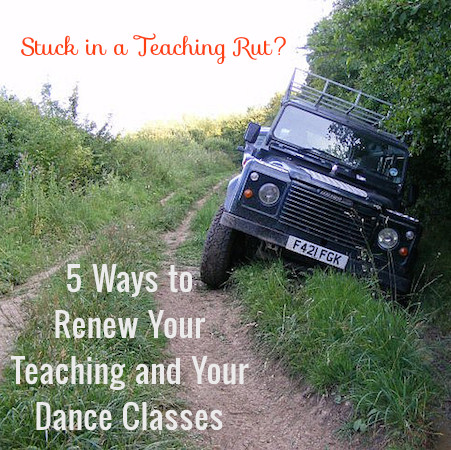Warm-up… Skill practice… Across-the-floor… and Stir
Warm-up… Skill practice… Across-the-floor… and Stir
There is a natural, appropriate, and often necessary order to dance instruction. Your students’ minds and bodies require the structure and repetition you provide for them week after week.
But what do you do when the patterns you’ve fallen into are boring you as well as your students?
Here are five ways to bring that old sparkle back to your teaching while upholding the foundations of a good dance class:
Set Creative Limitations
Setting limits for yourself can set you free, and may likely be the secret to some of your most creative ideas both in and out of the classroom. When you choreograph, it may seem the music, the number of dancers, or their abilities are the limiting structures but professional choreographers overcome creativity slumps or beat the blank slate syndrome by giving themselves a strict set of rules to follow. This can work in teaching too.
Try choosing one concept or one objective for each of your lessons and aim at that target as you develop each exercise.
The concept for Lesson One might be a basic element like tempo. Challenge yourself and your students with alternating speeds or trying things at unusual tempos throughout the class. Lesson Two may focus on the use of the head as an objective. Pay special attention to its use in all aspects of your class choreography. Creating limits or rules for your teaching can spark creativity in the classroom.
Involve your Students
Your students have great ideas, too. Find ways to involve them and you’ll find there’s a lot you can learn from your pupils. The range and scope of their involvement is up to you but here are some ideas to test drive:
- Ask open questions that require critical thinking: “Why do you suppose it’s important to keep your knees over toes in a plié?”
- Allow them to analyze and correct mistakes: “What’s wrong with the way I’m doing this step?”
- Request their suggestions: “Which music would you like to use next week?” or “Each of you give me one song you’d like me to use in class and I’ll try to incorporate them all in our next lesson.”
- Get their input on what, how, or when they’d like to learn or try a new skill: “I’ve been thinking about working with you on two kinds of turns, which would you like to learn first?”
Take Class from Someone Else
This one is pretty straightforward.
Getting away from your home base or working outside your comfort zone is always inspirational.
I know your location may make it difficult to find classes on your own level. But, who says you need to take an advanced or continuing education-style course to feel rejuvenated and brimming with new ideas?
Ask to observe or take class with other teachers at your own studio whether you teach the same subject or not. A hip-hop teacher’s particular approach may just inspire you to try something new in your ballet classes. In fact, you might make “company class” a regular part of your studio’s schedule with instructors taking turns teaching fellow teachers.
Heck, if dance isn’t an option try pottery, or a foreign language, or yoga, and let me know how this non-dance class enriches your own teaching – you may be surprised!
Try on a New Style
I’m not talking about a new dance style, though as mentioned, that can certainly get the juices flowing, too.
I’m talking about a new teaching style. Perhaps you fall neatly into one of the four categories of teachers. If so, why not explore another approach or experiment with mixing these styles within your class?
For instance, occasionally facilitate by splitting your students into groups to explore new concepts or work together on choreography. Or try delegating tasks, sending pupils home with a task to complete before the next class.
Give Class in 4D
A dance class is pretty 3D compared to a typical classroom environment. Your students get hands on, experiential instruction that they simply don’t when seated behind a desk. However…
Even dance can travel to another dimension by adding visual, tactile, and other sensory aids to the educational environment.
Having trouble getting students to understand turnout? Try a bandana affixed with a single eye. That’s right an eye. Strategically place the bandana around their lower thigh and train them to “look” in the right direction.
 Want to evoke a particularly delicate and light movement quality? Bring in a feather and show them how it floats. Encourage them to move like a feather on their own before bringing that movement to set choreography.
Want to evoke a particularly delicate and light movement quality? Bring in a feather and show them how it floats. Encourage them to move like a feather on their own before bringing that movement to set choreography.
These are just two examples. The possibilities are absolutely endless and require just a bit of imagination.
Now go on! Get off the hamster wheel of habit.
How will you bring that sparkle back to your classes, today?
Nichelle Suzanne is a writer specializing in dance and online content. She is also a dance instructor with over 20 years experience teaching in dance studios, community programs, and colleges. She began Dance Advantage in 2008, equipped with a passion for movement education and an intuitive sense that a blog could bring dancers together. As a Houston-based dance writer, Nichelle covers dance performance for Dance Source Houston, Arts+Culture Texas, and other publications. She is a leader in social media within the dance community and has presented on blogging for dance organizations, including Dance/USA. Nichelle provides web consulting and writing services for dancers, dance schools and studios, and those beyond the dance world. Read Nichelle’s posts.


